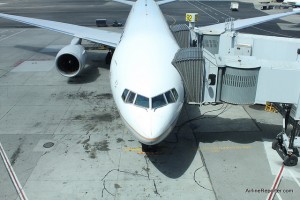
United Airlines Boeing 777 at San Francisco.
Airlines always seem to get a bad rap. Millions of people happily fly around the world and it seems to always be the negative stories that pop up. I recently was forwarded the below letter that was sent to United Airlines. I felt it was appropriate to share:
To Whom It may concern :
On Jan. 8th my husband and I boarded flight 927 from STL to SFO. We were returning to SFO . Then flying back to HNL. It was a very hard trip for us. We were carrying my brother’s remains . He was to be interred at, The National Cemetery of the Pacific, [Punchbowl]. We had just spend a week in Jefferson City, Mo. setting up the Memorial service and all the arrangements .
After the service, when the lights were dimmed, I found myself reflecting on the last few days. It was the first time my husband and I had actually had a few moments of quite. Soon tears started streamed down my face. A flight Attendant knelt down to my seat and ask if there was anything she could do. Then I explained the purpose of our trip. I shared with her the special flag that had been given to us during the, Military Honors Service . The kind words she shared help comfort me. Also the captain came out and offered his thoughts. I shared with him my brother’s love of flying and during his service to the Air Force traveled all over the world. Then one by one each crew member came to us and oftred their thanks to Bill for his service to his country.
When we landed in SFO the Captain came on the PA and made an announcement. He mention that this was Master Sgt. William Ralph Young Jr. final Flight and thanked my brother for his service to his country. As the passengers started to deplane many came up to us, some hugged us and some with tears in their eyes honored my brother. Thanking us for his many years of service to the United States. It was a unbelievable experience. I know my brother’s love for his country was deep. That love poured back on that final flight.
The crew was one of warmest and most thoughtful group of professionals I have seen in a long while. My husband and I will be forever grateful. I lost the names of the flight attendants , but I am hopeful they will receive my most sincere,”Thank you.” The wonderful Caption and First Officer , where Captain Timothy Gerner and F/O Robert Herrin.
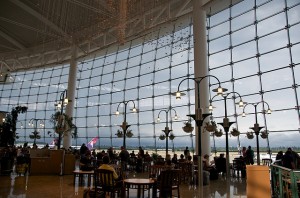
In April, passengers didn't have to spend a lot of extra time inside Seattle-Tacoma International Airport since many flights were on-time.
Happy news for Seattle and on-time performance. During April 2011, Seattle-Tacoma International Airport (SEA) had the most flights departing on-time than any other airport in the US, according to the Puget Sound Business Journal.
SEA had 84.97% of their flights leave on time, which puts them at the number one spot. Even when looking at all of North America, SEA comes in second, with Vancouver, BC (just north of Seattle) beating them out with 86.07% of their flights on-time.
Not only did Seattle’s airport do well, but Seattle’s hometown airline, Alaska Airlines did very well too.
Alaska was number 2 in April for most on-time flights with 89%, where Horizon Air (Alaska’s sister carrier) was number three with 86.33%. Not surprisingly, Hawaiian Airlines (which has a history of being the #1 carrier for on-time performance in the US) was first with 92.35% of their flights on-time.
Congrats to all those based in Seattle who work hard to make these results possible!
Image: Benji Stewart
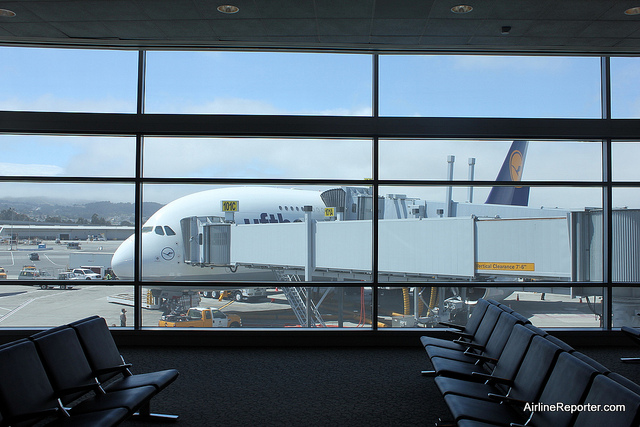
Lufthansa's Airbus A380 waits at SFO
Yesterday, San Francisco International Airport saw their first passenger carrying Airbus A380 arrive, operated by Lufthansa. Once all the passengers were able to de-plane and the aircraft was cleaned up (this was the first time that the SFO based cleaning crew cleaned up an A380), media and guests were able to take an inside look at one of Lufthansa’s seven Airbus A380’s.
I was excited, since this was my first time actually inside an A380. I had only seen one previously from the tarmac and of course I have viewed lots of photos, but there is nothing like getting inside the world’s largest commercial airliner.
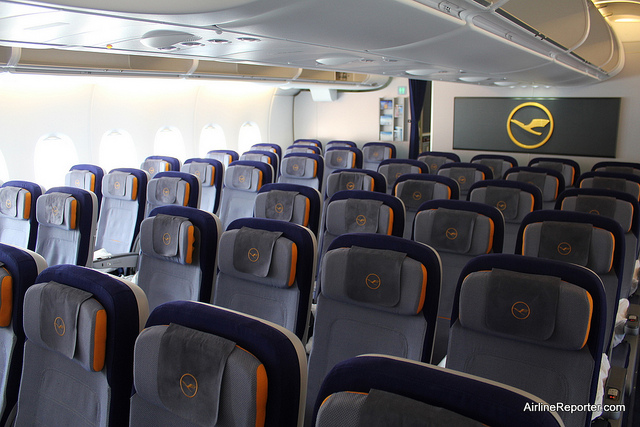
The economy class seats on Lufthansa's A380 look slick and are pretty comfy to boot.
Due to the A380’s size, there are three jetways options that passengers can board. Two are located on the bottom deck and one goes to the top. The tour started on the bottom where all 420 economy seats are located. Even though the bottom deck is long, but it doesn’t feel it, since it is broken up into individual sections. Every seat has their own in-flight entertainment system, adjustable headrest and ample legroom. Sitting in the seat, I was plenty comfortable for the three minutes I was there. Not too sure how my 6’1″, 250lbs frame would handle 11 hours if I had someone sitting next to me.
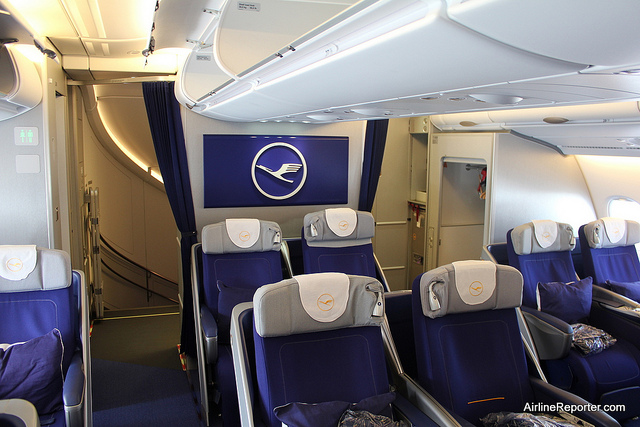
All the Business Class seats can be found on the upper deck of the A380.
On a longer flight, I would prefer to head up top where you can find 98 Business Class and eight First Class seats. One of the first things I noticed were all the seats on the aircraft were cloth. In most Business and First Class areas, one is more likely to find leather. This didn’t make the seats any less comfortable and most likely would reduce sliding when converted into a bed.
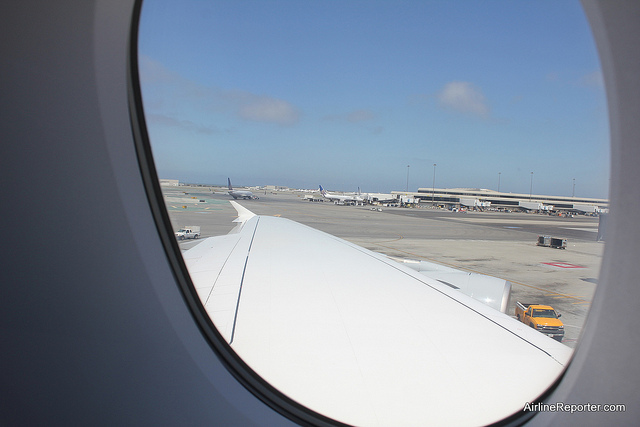
While on the upper deck, I took a look at the Airbus A380's massive wing.
While up on the second deck, I had a chance to sit down and take a look out the window. The Airbus A380 has one frek’n big wing. These large wings have 54% more surface area over a Boeing 747-400 and you can tell.
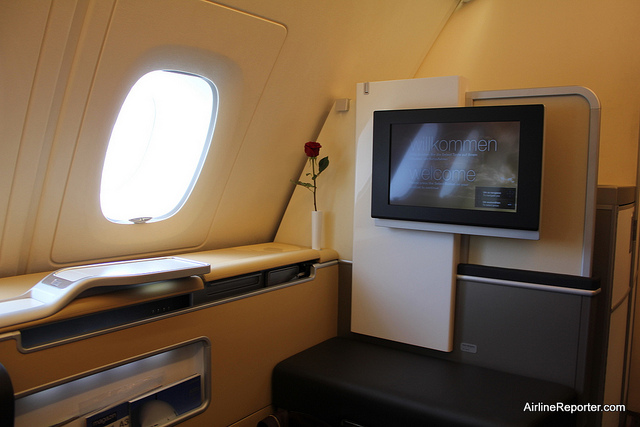
The new Lufthansa First Class has ample room and a large screen. I could easily burn 11 hours happily in this section.
The new Lufthansa First Class on the A380 was quite impressive. Each person has their own area, with large screen and fold down bed. The walls were covered in suede (or fake suede) and extra sound deadening is used to keep the sound to a minimum. The First Class cabin also has access to two very large lavatories. We are talking full sitting couch and vanity. If you ever wanted to join the mile-high club, this would be the place to do it — even all that extra sound deadening might help. From forks to roses, Lufthansa’s catering crew loads on 40,000 items for just the First Class passengers alone (yes, 40,000). That just goes to show the level of service that flying First Class provides.
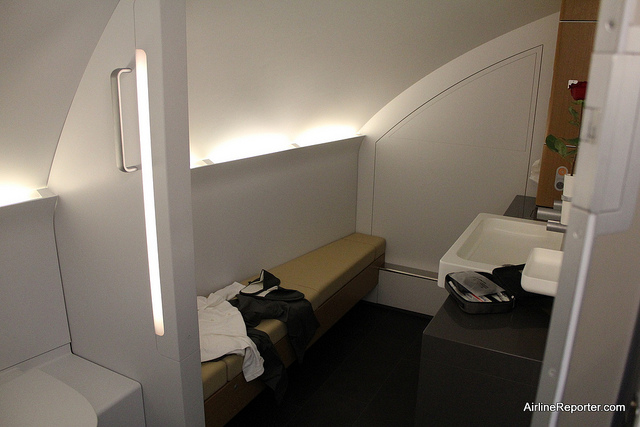
This is one of the lavatories in the First Class section. Can anyone say Mile High Club?
One thing you will find missing in the first class section are overhead bins — they are missing. Instead each seat has a storage area where passengers can store their belongings. This really adds a sense of upward space and makes the First Class cabin that much more comfortable. Even though the Business and First Class areas are what you might expect, it just doesn’t feel as exclusive on the top deck of the A380 versus the smaller top deck of the Boeing 747-400.
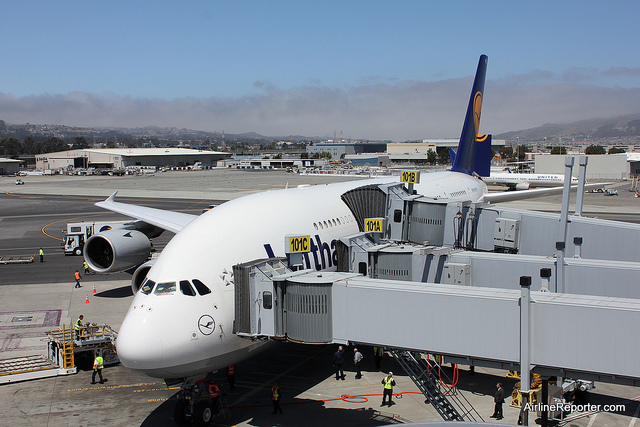
This is the first time I have seen three jet ways be used to de-plane an aircraft.
Although the A380 looks impressive pulling up to the gate, it is missing some of the grace that the Boeing 747-8 Intercontinental has in my opinion. The Airbus A380’s job is not to win any beauty contests, but to provide airlines with an economical way to move a lot of people in style and it does just that. After my tour of an A380 I am super pumped to get a ride in one and hope to write up a trip report soon.
For those of you who have flown in an Airbus A380 what have been your impressions?
CHECK OUT THE REST OF MY PHOTOS ON FLICKR
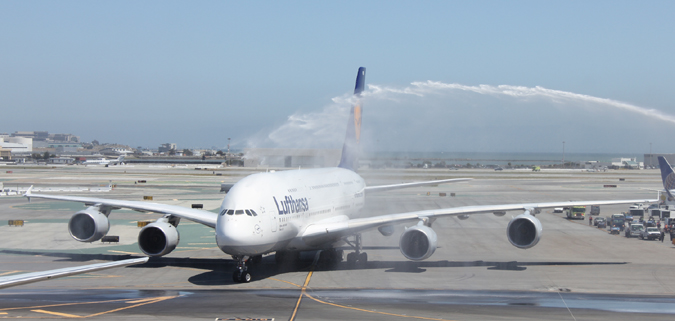
Lufthansa's Airbus A380 (D-AIMD) gets a water salute when arriving to San Francisco on May 10th.
Today was a beautiful day to fly down to San Francisco (SFO) to greet the Lufthansa’s first Airbus A380 passenger flight from Frankfurt, Germany to SFO.
The Airbus A380 is the largest passenger airliner made and it’s closest competitor will be the Boeing 747-8 Intercontinental, when it makes it to the market. I have been able to catch a glimpse of a Qantas Airbus A380 while in LAX, but this was my first time to get up close and personal. I do not think the A380 is as majestic as the Boeing 747, but she is very impressive for sure.
The event is a big deal for the airline and the city. San Francisco Mayor Edwin M. Lee has officially declared May 10, 2011, as “Lufthansa German Airlines Day.” Pretty cool when an airline gets an official city day. I am not sure it really means anything, but still neat.
The airport had to make very little updates to prepare for the A380, since the International Terminal was designed with the A380 in mind and it fit with no problems.
Lufthansa already has taken delivery of seven A380’s with an additional 15 on order.
As part of the event, we got a tour of the interior of the A380 and I will be posting that story tomorrow.
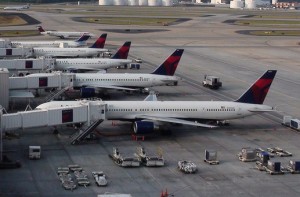
Delta aircraft lined up at Atlanta. You know where your bag is?
Delta Air Lines has been making the headlines this last week for kicked off passengers, bomb threats, and job cuts. That is part of the “fun” with being the world’s largest airline — something interesting is always happening. All those stories have been well-covered by other media outlets and I think one story that has fallen between the cracks: luggage tracking.
Having your luggage get lost while traveling is annoying — very annoying. Delta has started a new tracking system to help reduce lost luggage and allows passengers to follow along.
Once a passenger checks in their bag and they are scanned, they can start to follow its process to the bag carousel at their destination.
Delta is the first major airline to try such a new feature and so far they are hearing good things.” Customers have been asking for something like this and we’re pleased to get it up and running,” Delta spokesman Morgan Durrant explained to AirlineReporter.com. “The performance has been solid and initial customer feedback is positive.”
Currently this new feature is not integrated into Delta’s smart phone apps, but passengers are able to access it via Delta’s website on any internet-capable devices. So this means that when you board your flight, you might see that your bag did not make it. Although it will cause some disappointment during your flight, Delta flight attendants have gone through briefings on the new system and can better assist customers. This will save you time not having to wait at baggage claim for all the bags to come off before you realize yours didn’t make it. Then having to wait in line to let Delta staff know you do not have your bag.
According to the Wall Street Journal, “the rate of mishandled baggage was 3.59 reports filed per 1,000 passengers in February, an improvement of 8.7% from the prior year’s rate of 3.93 per 1,000 passengers.” Delta is ranked 5th out the airlines tracked by the Transportation Department.










